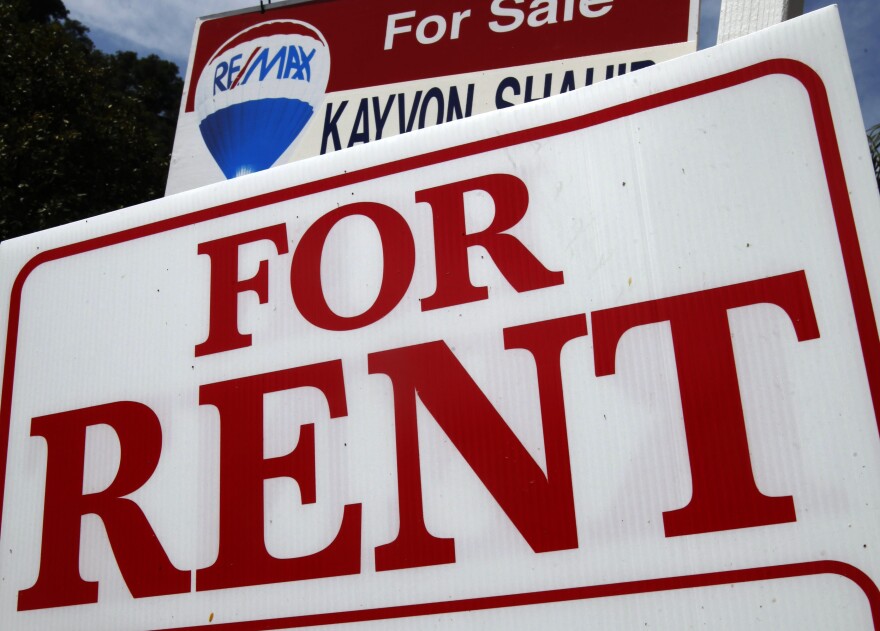Affordable housing has become a hot-button issue in Greater Cincinnati over the last few years, garnering media attention, promises from elected officials and no small amount of debate.
That debate is culminating in a ballot initiative called Issue 3 that is before Cincinnati voters May 4. If passed, it would require the city to spend $50 million a year on affordable housing.
Research has shown rising rents and big gaps between the number of available rental housing units and area residents, especially those with low incomes looking for housing they can afford in Hamilton County. Some skeptics question the exact number of units needed, however, and there is little consensus on how to address that need.
But let’s back up. What does it mean for housing to be affordable?
In all the discussion about housing, things get complex quickly. Federal and local subsidies for housing are riddled with acronyms and formulas that can be confusing at first glance. And some housing advocates say not all housing called "affordable" by those metrics directly addresses the needs recent research has suggested are the most pressing in Cincinnati and Hamilton County.
To that end, here is a quick tutorial on what constitutes "affordable" housing.
What Is "Affordable" Housing?
The federal government considers housing affordable when a person or family is spending no more than one-third of their income on rent or a mortgage plus utilities. A family is cost-burdened, meaning their housing is unaffordable, when they spend more than that. About 44,000 lower-income families in Greater Cincinnati are cost-burdened, according to a 2017 report by LISC Greater Cincinnati and Xavier University's Community Building Institute.
More than one in four Cincinnati households is below the federal poverty line — that's about $13,000 a year for a single person or $21,000 for a three-person family with one child — and those families generally can't afford housing at Cincinnati's Census-measured median rent of $709 a month. Instead, rent for a single person at that level that is affordable comes in at about $325 a month.

Key Affordable Housing Terms and Facts
- Affordable housing is generally considered housing that cost no more than one-third of a person or family's income including rent and utilities.
- AMI, or Area Median Income, is the measure of what the median household makes in a county or metropolitan area. See below for a chart of Greater Cincinnati's AMI.
- CMHA, or the Cincinnati Metropolitan Housing Authority, is the agency that administers public housing in Greater Cincinnati. It provides roughly 5,000 units housing 10,000 people with incomes below 50% of the area's median income.
- LIHTC, or Low-Income Housing Tax Credits, are issued by the federal government through the Ohio Housing Finance Agency to fund the construction – but not ongoing operation — of affordable housing built by private developers. Those developers compete for those credits and agree to keep their developments affordable at a certain level — generally between 30% and 80% of the Area Median Income — for at least 15 years. OHFA also runs other programs — such as the Ohio Housing Trust Fund — that fund affordable housing for low and moderate-income people.
- NOFA, or Notice of Funding Availability, is a competitive twice-yearly program the city of Cincinnati uses to award funds to developers for affordable housing and other development projects.
- OHFA, or the Ohio Housing Finance Agency, is the state agency responsible for funding affordable housing and administering federal tax credits for it.
- Section 8 is a program that allows low-income residents the opportunity to choose their rental housing, so long as a landlord accepts the vouchers issued by HUD for housing. CMHA administers about 11,000 Section 8 vouchers in Greater Cincinnati. Some Section 8 vouchers are also attached to specific buildings instead of residing with tenants.

How Is Affordable Housing Created?
In some cases, the market dictates rents that match up with the incomes of people in the area who need housing. That kind of housing, sometimes called "naturally affordable," however, has decreased in recent years — either due to rising rents or disinvestment that has left it vacant or in an unlivable condition.
Some proponents, including Cincinnati City Council Member Jan-Michele Lemon Kearney, have suggested easing zoning regulations to allow for the construction of more multi-unit buildings. That would increase supply of housing units, lowering prices, the logic goes.
But even advocates of such approaches admit that won’t meet all the need. To bridge the gap in market rate housing that is affordable, subsidy is often needed from federal, state or local governments.
The U.S. Department of Housing and Urban Development (HUD) funds both public housing through the Cincinnati Metropolitan Housing Authority (which operates about 5,000 units housing 10,000 people) and subsidized housing owned by private landlords through the Section 8 program (which serves about 11,000 people in Greater Cincinnati).
Both of these programs have long waiting lists, and those waiting lists aren’t even always open. The programs have income maximums — generally 50% of the area's overall median income, or about $28,000 a year for a single person — that decide who is and isn't eligible.
The federal government also partners with the private market to provide affordable housing via the Low Income Housing Tax Credit (LIHTC) program. Developers compete for these tax credits each year, which are paid for by HUD and administered by the Ohio Housing Finance Agency (OHFA). Developers who win them use them to attract investors — generally, corporate entities that pay somewhat less than face value to use the tax credits upfront so they can reap longer-term tax savings. In return, developers get about 70% of the capital they need to construct housing. LIHTC isn't used to operate that housing, however, though developers can often opt to accept Section 8 for rent as well.
OHFA also runs other programs like the Ohio Housing Trust Fund that are used to help create affordable housing for low-and-moderate-income people in the state. Including LIHTC, OHFA says it has funded more than 100,000 units of affordable housing across the state since 1987, including 7,000 in Cincinnati.
Cincinnati also administers some federal dollars it puts toward subsidized housing projects through a process it calls Notice of Funding Availability. NOFA awards can be used to close financing gaps in affordable projects. The city also awards NOFA for some projects without affordability benchmarks that the city administration determines are beneficial and would not otherwise happen without subsidy.
"Affordability" Is Relative
Developers receiving these subsidies agree that the housing they build must remain affordable for at least 15 years at an agreed-upon level that is determined by a measure called "Area Median Income," or AMI.
Here, things get a little tricky.
HUD uses the U.S. Census Bureau's measurement of AMI for counties and metropolitan statistical areas (MSA) like Cincinnati and generates AMI figures for various household sizes. AMI for a single-person household in Greater Cincinnati, for example, is about $59,800 a year, per HUD.
Rents on LIHTC, or some NOFA developments, depend on a developer's application. They can be affordable to people making between 30% AMI (up to about $18,000 for a single person, or $450 a month in rent and utilities) to 80% AMI (up to about $47,850, or $1,196 a month in rent and utilities for a single person) or more.
There is another set of benchmarks associated with more moderate to middle-income earners called "workforce housing," occasionally called "workforce affordable housing." Those projects are generally between 80% AMI and 120% AMI — units that can go as high as $1,500 a month for a single person, using HUD's 30% of income metric.

2021 AMI Levels (And Associated Monthly Rents) For Greater Cincinnati (Per HUD)
- 30% AMI: $17,950 for a single person maximum; at that income, up to $450 a month in rent and utilities is affordable
- 60% AMI: $35,868 for a single person maximum; up to $896 a month in rent and utilities is affordable at this income
- 80% AMI: $47,850 for a single person maximum; up to $1,196 a month in rent and utilities is affordable at this income
- 100% AMI: $59,800 for a single person maximum; up to $1,495 a month in rent and utilities is affordable at this income

Do Local Efforts Match the Need?
The 2017 Community Building Institute/LISC Greater Cincinnati study identified a need for roughly 25,000 units of housing in urban areas in Hamilton County (Cincinnati and Norwood) affordable for people making under about $15,000 a year or less — that is, less than 30% AMI or near federal poverty guidelines. Countywide, the study found a 40,000-unit gap for those income levels. That gap grows much smaller as income goes up.
But some critics say that data, from 2009-2014, is too old to be accurate.
More recent data from HUD uses numbers from 2013-2017, using the same income level of 30% AMI. An analysis from the National Low Income Housing Coalition shows a deficit of 29,700 affordable and available units in Hamilton County, and a deficit of 19,230 units in the city of Cincinnati.
Other data from HUD for that time period suggests roughly 37,000 of Cincinnati’s 85,000 renter households were struggling with housing affordability, of which about 33,500 were moderately to very low income.
An even more recent NLIHC report, published in March, offers estimates for the Cincinnati metro area based on a single year of ACS data from 2019: a deficit of 49,999 affordable and available units across the 15-county Tri-State area. The researchers say using a single year of ACS data is useful for larger areas, but should not be used for county- or city-level estimates.
Proponents of Issue 3, including some social service providers, say the area faces a huge need, regardless of what the exact number of units needed is. They also point out that using AMI as a gauge of affordable housing need in Cincinnati’s low-income neighborhoods is a problem in and of itself. That's because there is a big mismatch between the overall median income of the entire metropolitan area — including much wealthier suburbs — and its historically low-income neighborhoods where housing is being built.
For example, median income for one person in the entire metropolitan area is $20,000 higher than it is in Cincinnati, and HUD's 60% AMI level for the metropolitan area is well more than double the $15,000 median household income found in neighborhoods like the West End. So housing considered "affordable" by that area-wide measure may still be far more than residents in some communities can pay.
As a vote on Issue 3 looms, Cincinnati officials have floated a number of alternative plans to fund affordable housing creation. Those include a proposal from city of Cincinnati administration that would have the city apply for $34 million in special federal funds that could be used for loans to developers building affordable housing.
Other cities have taken similar routes to those under consideration in Cincinnati. In 2019, Columbus voters approved a bond issue that will generate $50 million for affordable housing and Franklin County paid another $17 million into that fund. Meanwhile, private investment from banks and other corporations poured $100 million into another fund for affordable housing.
WVXU government reporter Becca Costello contributed to this story.



